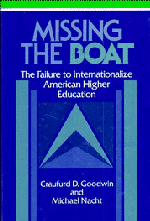Book contents
- Frontmatter
- Contents
- Introduction
- 1 Higher education looks abroad: historical trends
- 2 Who goes today? and who does not?
- 3 Individual costs and benefits
- 4 Campus attitudes
- 5 Obstacles to international experience
- 6 Issues for debate
- 7 Cases studies
- 8 Epilogue: missing the boat
- Appendix: institutions visited
- Index
1 - Higher education looks abroad: historical trends
Published online by Cambridge University Press: 04 August 2010
- Frontmatter
- Contents
- Introduction
- 1 Higher education looks abroad: historical trends
- 2 Who goes today? and who does not?
- 3 Individual costs and benefits
- 4 Campus attitudes
- 5 Obstacles to international experience
- 6 Issues for debate
- 7 Cases studies
- 8 Epilogue: missing the boat
- Appendix: institutions visited
- Index
Summary
Postgraduate training and the grand tour
Faculty members in U.S. colleges and universities have ventured overseas from the very earliest days. As leaders of a colonial culture, they looked back to their metropolitan heartland for direction. Later, within an adolescent new community they turned still to the Old World for intellectual training, leadership, standards, and inspiration. They went back not only to Britain in search of roots, but to the continent as well for the experience of postgraduate training and a breadth of contacts appropriate to a young developing nation. Continental Europe remained the destination of most itinerant U.S. scholars throughout the nineteenth century. The main exceptions were clerics who set out for mission stations in Asia and Africa or the Holy Land. A few “orientalists” brought back reports from the mysterious East, but mainly in the form of travelers' tales and stories from exotic lands rather than as serious scholarly studies. The dominant posture of these early U.S. scholars abroad was often respectful humility toward their elders and betters; they came primarily to watch and to learn and, except for the missionaries to the heathen, seldom to teach or to contribute. Some of the expatriates were even openly contemptuous and ashamed of the society they left behind, and they apologized for the philistine ways of those who stayed at home. Scholarly travel was for practical reasons the preserve principally of those with private wealth, and to some degree the study tour of young Americans became associated, in fact and in public perception, with the continental grand tour of young British aristocrats.
- Type
- Chapter
- Information
- Missing the BoatThe Failure to Internationalize American Higher Education, pp. 1 - 10Publisher: Cambridge University PressPrint publication year: 1991



